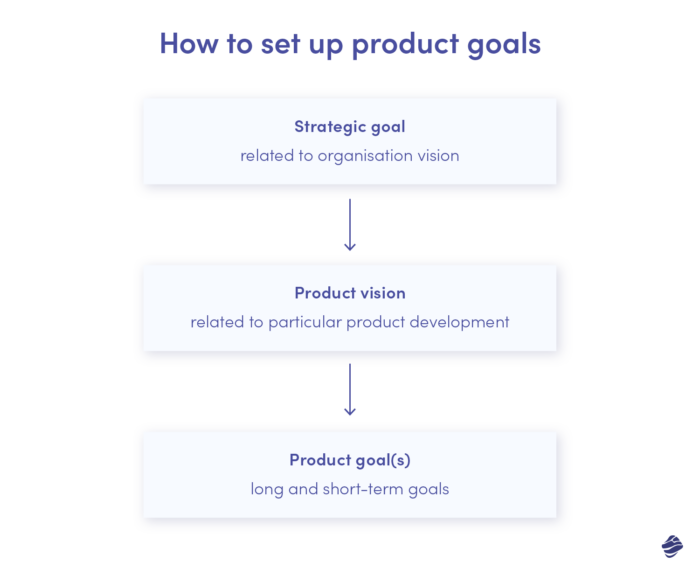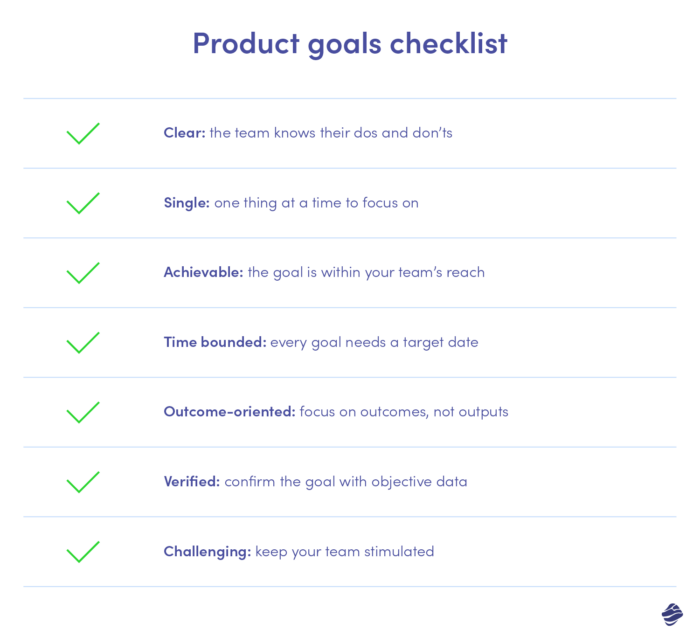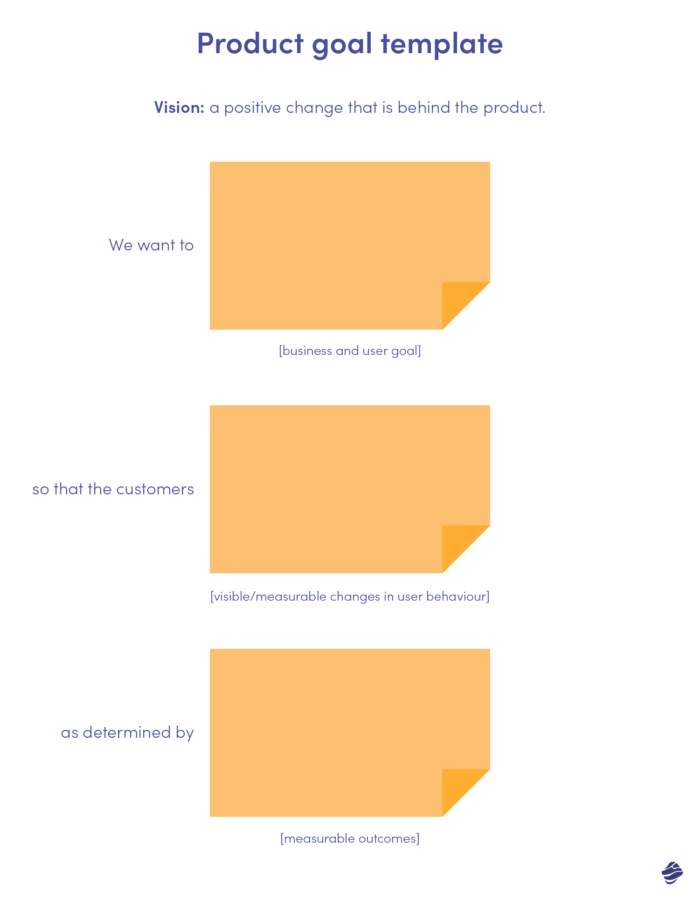Regardless of whether the product is being created from scratch or it already has been released, there have to be long-term product goals and digital product strategy established, so that the product development and its success can be proved over time.
From my personal experience working with many companies in the last years, I noticed that even if the stakeholder and the team are aware of the product goals they want to achieve in general – as soon as the product development starts – they tend to forget about them.
The most common product goals challenges
I think that the reason behind it is that mistakenly setting up product goals might not be considered a matter of product design. Most stakeholders keep their business goals confidential as they don’t realise their impact on what, when and how the product should be developed. They expect to achieve their business goals but deny full transparency – and get easily frustrated as the product team does not deliver the desired outcomes.
Moreover, stakeholders tend to focus on something different from the current customers’ needs or changes in the market. Frequently, they are biassed by their own assumptions and beliefs about their own ideas – that haven’t been verified with the market or potential customers.
Finally, sometimes, goals do not reflect the real organisational opportunity in the market due to lack of research or not specified product goals. The product goals are not measurable, therefore impossible to verify over time.
What is a product goal
But let’s go back to the basics for a moment. What is a product goal? In short, a product goal is this one essential accomplishment that will turn your vision into reality. Product goals should be measurable, time-bound, and support what the company strives to achieve. The right product goals should reflect the company’s business strategy and highlight the product’s contribution to achieving business objectives.
How to set up product goals
The product goals and intiatives should be the reflections of the business strategy. Meanwhile, companies I have been working with tend to focus on the revenue and number of active users – core metrics defined in a Product Vision at the beginning of the process.

Set up one long-term goal first
So how to set up the right product goal? The product team’s job is to pick one goal that would meet the business and user’s expectations by following these rules:
1. The goal goes in line with the business and product strategy itself. Think about the reason why this goal needs to be achieved and how it is going to help in the business. Ensure the stakeholders are transparent about their enterprise product strategy.
2. The goal is accurate. When the accuracy goal of product roadmap is achieved, the team draws conclusions and continues to search for improvements. Think about the opportunities behind the business and identify the spots on the product roadmap to verify your goals.
3. The goal is measurable. In other words, translate your goals into specific numbers or data that will help you prove the product’s growth or decide if the goal is still valid. Consider quantity and quality metrics, such as the number of users per day/week/month or positive/negative feedback from users. The metric can also be an observation – a visible change in customers’ behaviour.
What should you do if there is more than one long-term goal? Prioritise them or think about the broader one. Sometimes one long-term goal might be connected with or lead to another. The crucial thing here is to focus on one goal at a time.
Cut the long-term goal into smaller pieces
Now, having one long-term goal on your plate, review its business context and potential customers’ needs together. From my perspective, the product brings expected revenue only when its users’ needs are taken care of.
Think about specific product increments that should be delivered to achieve this goal and the benefit they might bring to the users. List all ideas and prioritise them regarding their impact on business and users and the effort the team shall make to deliver them.
Translate all ideas into short-term goals – for example – sprints’ goals as a strategy to achieve the high-level target. Then put them on a timeline accordingly. Again make sure they are accurate and measurable.
Repeat that exercise every time when setting up goals during the product discovery workshops or while discovering new features.
Product Goals Checklist
Once you have set up the first long-term goal and designed the path to achieve it within the short-term/sprint goals, it’s time to review their structure. To be secure if the goal’s structure is correct, make sure it is:
- Clear – the goal should be clear and understandable so that the team knows what to do and what not to do.
- Single – there should be one thing at a time to focus on during the sprint. Make sure the team is not distracted by various goals to be achieved in a certain period of time. Brainstorm about potential ways to achieve a goal and then pick *the one* way to follow.
- Achievable – so that the team won’t fail when achieving it. Assume the emergency buffer in the sprint or divide big tasks into small chunks.
- Time bounded – every goal needs a target date so that the team knows the deadline to focus on and something to work toward.
- Outcome-oriented – ideally, focus on outcomes, not outputs. Once you focus on the end result, especially when it is number-oriented or has a visible change in customer behaviour, it will be helpful for the team to measure its success.
- Verified – the value behind the goal must meet the business and customers’ expectations and be confirmed within any objective data, such as quantity or quality numbers, observation or written report. According to Hubspot’s report, relying solely on assumptions is the key reason for the failure of nearly 42% of startups.
- Challenging – so that the team will be stimulated and not be bored. Goals are proven to give focus, knowledge integration – especially when the team is multidisciplinary and they increase teams’ effectiveness.

How not to lose the right track when following the product goals
Every time you set a short-term or a long-term goal, make this list a team’s duty:
- Set the validation frequency. Decide with your team how often to verify the progress. Depending on the deadline, verify your goals’ validity and the progress you make each or/and every couple of sprints.
- Choose metrics to follow. Decide how you will know if the goal takes you in the right direction by setting accurate metrics – for example, start with low-effort metrics such as user feedback.
- Inspect and use data. It means that the team should constantly be aware of their work’s impact on the business and learn how to use it. The good idea is to devote one meeting during the sprint to present and discuss the data. Always brainstorm your conclusions and consider how to use them to improve the product.
- Observe the leading and lagging indicators. Asking the right questions is the most challenging yet valuable skill in product design. The team should decide which measures lead them to their goal and which should be changed to observe any progress by looking for specific answers to their questions.
- Be flexible when setting goals. Observing the companies over time, I have noticed that they easily attach to their goals as soon as they are set. This lack of flexibility might be harmful, as goals most surely will change over time or will no longer be valid due to the current financial situation, changing world, new market opportunities or simply negative customer feedback. It is the team’s call to be alert when the situation is changing and adapt new ideas to ensure an excellent product-market fit.
Pivot, pivot! Validate your product goals
Focusing on the wrong goal happens and usually causes the company’s loss of money and time. So again, make sure that the goals you set are measurable, accurate and in line with the business strategy in the first place to be more secure about them.
Sometimes, even though the goals were set correctly, they are impossible to be reached. According to my expertise, the reason is that company leaders aren’t data experts and are not technically involved enough to know what data they need to answer their business questions.
Therefore, it is crucial for product managers to systematically validate the goals during the process, within the research, user feedback and with stakeholders’ business perspective. Product designers should educate companies about changing their objectives depending on the data to protect money and time. It is their duty to evangelise about an unrealised value in the market that might come out along the way, whereas it can be easily translated into profit.
Product goals examples
According to Roman Pichler’s article Product goals in Scrum, there are clear differences between product vision and the business, product and sprint goals, such as:
Product vision: Defines a very broad idea behind the company’s vision or a positive change that it brings to the world, such as: Help people eat healthy
User and Business Goal: Focuses on the particular customer’s need and the business problem that has to be solved, for example: Reduce the risk of developing type-two diabetes.
Product Goal: It is related to the unique value the product brings, for example: Help the users to set their proper eating habits.
Sprint Goal: Focusing on the specific increment delivered towards achieving the product goal, that should be validated. For example: validate that users are willing to share personal information when activating the app.
However, using them as such, will not be useful in the product development process as there are no metrics provided in order to measure the progress. Therefore let’s take a look at the product goal template that I happen to use quite frequently when setting the product goals:

By setting a measurable and outcomes oriented goal, the team will be able to track the specific numbers in order to prove their progress.

![[header] how to set product goals examples and best practices](https://www.miquido.com/wp-content/uploads/2023/02/header-how-to-set-product-goals-examples-and-best-practices.jpg)





